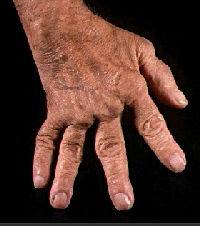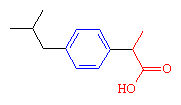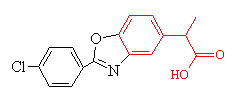 | Rheumatoid arthritis can result in severe deformation of the hands wrists, feet, ankles and hip joints, and causes severe pain, swelling and restricted movement. |
Ibuprofen is a well-known drug that is used to treat the symptoms of rheumatism and arthritis. Such illnesses are very disabling, and the sufferers rarely die and rarely get better. This means there is a huge market for drugs that relieve pain and swelling and reduce inflammation. In fact, 7 of the top 100 best selling drugs in the world are anti-inflammatory drugs of this type.
 | Rheumatoid arthritis can result in severe deformation of the hands wrists, feet, ankles and hip joints, and causes severe pain, swelling and restricted movement. |
For over half a century, the only anti-inflammatory drug available was aspirin. However this caused problems for arthritics who needed to take the drug regularly and in large doses, often for the rest of their lives. Under such conditions, the minor side-effects of aspirin, such as stomach irritation and bleeding became serious. Alternatives were tried, such as paracetamol, but this only relieved the pain and did nothing to relieve the inflammation. Cortisone, the first steroid-based drug, was discovered in 1948, and was hailed as a miracle cure - but then reports of it causing problems with essential salt, sugar and protein metabolism soon caused disillusionment.
The search then began for safer, non-steroid anti-inflammatory drugs. A number were discovered soon after WW2, and the most common group are the a-arylpropionic acids, shown below. This simply means the molecule contains an aryl group (the benzene ring), joined to a carboxylic acid derived from propane (3 carbons). The most well known of these drugs is ibuprofen. It was authorised for over-the-counter sale in both the UK and US in the late 1980s, and was probably the first new chemical entity to be given this authorisation for about 20 years. Its name comes from a contraction of the various parts of its structure, the sidegroup iso-butane, the propionic acid, and the phenyl ring.
 | Ibuprofen - the benzene ring is shown in blue and the propionic acid is shown in red |
 | Naproxen the ibuprofen part of the structure is shown in red |
 | Fenoprofen |
 | Benoxaprofen |
Other drugs based on the same structure include naproxen (which is more powerful than ibuprofen) and fenoprofen. The mode of action of these drugs is still unclear, but they are all acidic, and this seems to be an important structural requirement. They are believed to function in the same way as aspirin, by inhibiting the formation of inflammatory chemicals called prostoglandins. Unfortunately, these prostoglandins also play a role in the formation of stomach mucus, so a side-effect of these drugs is to cause stomach problems. An example is, benoxaprofen, which came onto the market in the early 1980s and promised to be powerful and novel anti-inflammatory drug with only one tablet per day being required. Half a million patients took it in its first six weeks on the US market. However, reports of side-effects including serious internal bleeding, kidney and liver damage, and sensitivity to sunlight, and its implication in almost 80 deaths in the UK and 30 in the US, led to it being withdrawn in 1982.